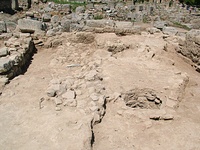| Collection: | Corinth | |
| Type: | Basket | |
| Name: | Nezi Field, context 5603 | |
| Area: | Nezi Field | |
| Context Type: | Wall | |
| Title: | E-W Wall #5 identified by 1963 excavations | |
| Category: | Cut | |
| Notebook: | 1101 | |
| Context: | 5603 | |
| Page: | 0 | |
| Date: | 2008/05/22 | |
| Stratum: | 10% inclusions: angular cobbles, platy; small round pebbles, small round cobbles | |
| Description: | Top slope of the context is level. The soil color is light reddish brown. The soil compaction is loose. The soil is poorly sorted. It is sandy silt. Structure materials: limestone, marble. Material size: 0.27 m L x 0.23 m W x 0.27 m H (max). Material finish: rough hewn. Material construction: random coursed. Material bonding: none. | |
| Notes: | This wall was first uncovered during 1963 excavations, and was recorded by Charles Williams (1963, NB. 253, drawn pp. 23, 26; described pp. 27-29). The ~ 1.0 m space between wall 5603 and S-lyng Wall 6 was drawn and explored, and was found to contain a a substantial amount of disintegrated mudbrick, charcoal, plaster, and tiles lying on edge. It seemed to Williams at the time that he was seeing a space lying on edge. It seemed to Williams at the time that he was seeing a space that may have been used as a staircase. He posited that this was so becaue of the corridor- like appearance of the space between the walls. However, it seems more likely that the walls should be considered in variant phases, as their construction differs. The construction Wall 5603 is so flimsy that it is difficult to imagine what structured purpose it could possibly have served. The underlying foundations of cobble are more substantial in appearance, though, so perhaps this wall once had more to it. Note, 20.05.08: After the excavation of 5623, we notice that a layer of cobbles to the E of where 5603 had been removed appeared pedestalled. They appear to represent a continuation of the line of 5603 rather than having functioned as part of the foundations. The cobbles had been exposed in the excavation of context 5620, but it was not clear that they were actually pedestalled until 5623 was removed. When they area excavated, they should be linked with 5603; this may result in a cleaner line for the underlying cobble foundations 5604 as well--- a question that was troubling J.H. when he drew them. Aslso, the pickman has defined what may be a soil matrix employed for the setting of Wall 5603. I use the long-winded terminology because it is so small and shallow--only abot 10 cm of soil. But it is a harder edge with the impression of stones visible in it, exposed aslso at the end of the excavation of 5623. This means that the new context revealed to the N of the cobbles represents the fill that was cut for the insertion of 5603. It also means that the new wall recently exposed during the excavation of 5623 predates the setting line of wall 5603. | |
| Context Pottery: | Fineware. ww plain (700-1120), dish. 1 rim. ; Coarseware. amphora. 3 bodysherds. ; Fineware. premedieval2 bodysherds. ; Coarseware. outturned rim amphora (975-1100), amphora. 1 rim. | |
| Pottery Summary: | 4 frag(s) 0.01 kg. (0% saved) fineware. | |
| 44 frag(s) 0.88 kg. (0% saved) coarseware. | ||
| 4 frag(s) 0.04 kg. (0% saved) cooking ware. | ||
| Context Artifacts: | glass, green, clear bs 1; glass, clear, yellow bs 1 | |
| Period: | No precise date (NPD) | |
| Grid: | 262.74-261.15E, 1036.07-1036.49N | |
| XMin: | 261.15 | |
| XMax: | 262.74 | |
| YMin: | 1036.07 | |
| YMax: | 1036.49 | |
| Site: | Corinth | |
| City: | Ancient Corinth | |
| Country: | Greece | |
| Masl: | 84.91-85.41m. | |
| References: | Report: Nezi Field 2008 by Sarah Lima (2008-04-07 to 2008-06-13) Image: digital 2008 0138 |
|
